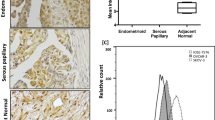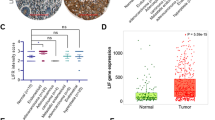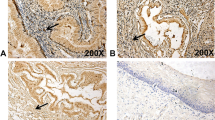Abstract
Purpose
Stroma-derived factor-1 (SDF-1) and its receptor C-X-C chemokine receptor-4 (CXCR4) are involved in human endometrial carcinoma (EC) progression. CXCR7 is another important receptor of SDF-1 and has a higher affinity with SDF-1 compared with that of CXCR4. This paper aims to study the effects of the SDF-1/CXCR7 axis on the growth and invasion ability of EC cells.
Methods
CXCR7 expression was evaluated by quantitative RT-PCR, immunohistochemistry, immunocytochemistry and Western blotting in EC cell lines and 30 cases of primary EC tissue from patients. EC cell line proliferation and migration were assessed following knockdown of CXCR7 by MTT and transwell assays.
Results
The results showed that CXCR7 was highly expressed at both mRNA and protein levels in the EC cells and tissue. siCXCR7 effectively silenced CXCR7 in Ishikawa and AN3CA cells. Treatment with 17β-oestradiol (17β-E2) significantly increased the levels of CXCR7 and SDF-1 in Con, siCon and siCXCR7 treated Ishikawa. siCXCR7 persistently inhibited CXCR7 expression, even in cells treated with 17β-E2. Moreover, in vitro functional analyses, silencing CXCR7 resulted in decreased proliferation in Ishikawa and AN3CA cells. Treatment with 17β-E2 and SDF-1 significantly promoted the growth and migration in siCon treated Ishikawa and AN3CA. Interestingly, in response to 17β-E2 and SDF-1 stimulation, siCXCR7 continuously inhibited the growth and invasion of Ishikawa and AN3CA cells.
Conclusion
Our results indicate that SDF-1/CXCR7 plays a positive role in the proliferation and invasion of EC cells. CXCR7 inhibition treatment may provide a promising strategy for anti-tumour therapy for EC.




Similar content being viewed by others
References
Jemal A, Bray F, Center MM, Ferlay J, Ward E, Forman D (2011) Global cancer statistics. CA Cancer J Clin 61:69–90
Rasool N, Fader AN, Seamon L, Neubauer NL, Shahin FA, Alexander HA et al (2010) Grade 3 endometrioid adenocarcinoma of the endometrium: an analysis of clinical outcomes and patterns of recurrence. Gynecol Oncol 116:10–14
Rabinovich A (2016) Neo-adjuvant chemotherapy for advanced stage endometrial carcinoma: a glimmer of hope in select patients. Arch Gynecol Obstet 293:47–53
Balkwill F (2004) Cancer and the chemokine network. Nat Rev Cancer 4:540–550
Chen N, Jiang X, Wang J, Wu T, Cheng B, Xia J (2016) CXCL12-CXCR4/CXCR7 axis contributes to cell motilities of oral squamous cell carcinoma. Tumour Biol 37:567–575
Teicher BA, Fricker SP (2010) CXCL12 (SDF-1)/CXCR4 pathway in cancer. Clin Cancer Res 16:2927–2931
Liao YX, Zhou CH, Zeng H, Zuo DQ, Wang ZY, Yin F et al (2013) The role of the CXCL12- CXCR4/ CXCR7 axis in the progression and metastasis of bone sarcomas (review). Int J Mol Med 32:1239–1246
Hattermann K, Mentlein R (2013) An infernal trio: the chemokine CXCL12 and its receptors CXCR4 and CXCR7 in tumor biology. Ann Anat 195:103–110
Burns JM, Summers BC, Wang Y, Melikian A, Berahovich R, Miao Z et al (2006) A novel chemokine receptor for SDF-1 and I-TAC involved in cell survival, cell adhesion, and tumor development. J Exp Med 203:2201–2213
Wang J, Shiozawa Y, Wang J, Wang Y, Jung Y, Pienta KJ et al (2008) The role of CXCR7/RDC1 as a chemokine receptor for CXCL12/SDF-1 in prostate cancer. J Biol Chem 283:4283–4294
Salazar N, Muñoz D, Kallifatidis G, Singh RK, Jordà M, Lokeshwar BL (2014) The chemokine receptor CXCR7 interacts with EGFR to promote breast cancer cell proliferation. Mol Cancer 13:198
Tsukamoto H, Shibata K, Kajiyama H, Terauchi M, Nawa A, Kikkawa F (2007) Uterine smooth muscle cells increase invasive ability of endometrial carcinoma cells through tumor-stromal interaction. Clin Exp Metastasis 24:423–429
Miao Z, Luker KE, Summers BC, Berahovich R, Bhojani MS, Rehemtulla A et al (2007) CXCR7 (RDC1) promotes breast and lung tumor growth in vivo and is expressed on tumor-associated vasculature. Proc Natl Acad Sci USA 104:15735–15740
Yang DL, Xin MM, Wang JS, Xu HY, Huo Q, Tang ZR et al (2015) Chemokine receptor CXCR4 and its ligand CXCL12 expressions and clinical significance in bladder cancer. Genet Mol Res 14:17699–17707
Smolkova B, Mego M, Horvathova Kajabova V, Cierna Z, Danihel L, Sedlackova T et al (2016) Expression of SOCS1 and CXCL12 proteins in primary breast cancer are associated with presence of circulating tumor cells in peripheral blood. Transl Oncol 9:184–190
Yang D, Dai T, Xue L, Liu X, Wu B, Geng J et al (2015) Expression of chemokine receptor CXCR7 in colorectal carcinoma and its prognostic significance. Int J Clin Exp Pathol 8:13051–13058
Zhu L, Luo K, Gu XH, Hou N, Huang CP, Lou Q et al (2015) CXCR7 expression in nasopharyngeal carcinoma tissues correlates with disease severity. Int J Clin Exp Med 8:21257–21261
Walentowicz-Sadlecka M, Sadlecki P, Bodnar M, Marszalek A, Walentowicz P, Sokup A et al (2014) Stromal derived factor-1 (SDF-1) and its receptors CXCR4 and CXCR7 in endometrial cancer patients. PLoS One 9:e84629
Wan L, Zou Y, Wan LH, Wang LQ, Huang MZ, Wu J et al (2015) Tanshinone IIA inhibits the proliferation, migration and invasion of ectopic endometrial stromal cells of adenomyosis via 14-3-3ζ downregulation. Arch Gynecol Obstet 292:1301–1309
Naumann U, Cameroni E, Pruenster M, Mahabaleshwar H, Raz E, Zerwes HG et al (2010) CXCR7 functions as a scavenger for CXCL12 and CXCL11. PLoS One 5:e9175
Maksym RB, Tarnowski M, Grymula K, Tarnowska J, Wysoczynski M, Liu R et al (2009) The role of stromal-derived factor-1–CXCR7 axis in development and cancer. Eur J Pharmacol 625:31–40
Liu P, Long P, Huang Y, Sun F, Wang Z (2016) CXCL12/CXCR4 axis induces proliferation and invasion in human endometrial cancer. Am J Trans Res 8:1719–1729
Gelmini S, Mangoni M, Castiglione F, Beltrami C, Pieralli A, Andersson KL et al (2009) The CXCR4/CXCL12 axis in endometrial cancer. Clin Exp Metastasis 26:261–268
Sun H, Wang X, Zhang Y, Che X, Liu Z, Zhang L et al (2016) Biglycan enhances the ability of migration and invasion in endometrial cancer. Arch Gynecol Obstet 293:429–438
Wormke M, Castro-Rivera E, Chen I, Safe S (2000) Estrogen and aryl hydrocarbon receptor expression and crosstalk in human Ishikawa endometrial cancer cells. J Steroid Biochem Mol Biol 72:197–207
Gehrig PA, Bae-Jump VL (2010) Promising novel therapies for the treatment of endometrial cancer. Gynecol Oncol 116:187–194
Attar R, Agachan B, Kuran SB, Cacina C, Sozen S, Yurdum LM et al (2010) Association of CCL2 and CCR2 gene variants with endometrial cancer in Turkish women. In Vivo 24:243–248
Sauvé K, Lepage J, Sanchez M, Heveker N, Tremblay A (2009) Positive feedback activation of estrogen receptors by the CXCL12-CXCR4 pathway. Cancer Res 69:5793–5800
Yan X, Cai S, Xiong X, Sun W, Dai X, Chen S et al (2012) Chemokine receptor CXCR7 mediates human endothelial progenitor cells survival, angiogenesis, but not proliferation. J Cell Biochem 113:1437–1446
Zabel BA, Lewén S, Berahovich RD, Jaén JC, Schall TJ (2011) The novel chemokine receptor CXCR7 regulates trans-endothelial migration of cancer cells. Mol Cancer 10:73
Acknowledgements
This work was supported by the National Natural Sciences Foundation of China (No. 81001154).
Author information
Authors and Affiliations
Corresponding authors
Ethics declarations
Conflict of interest
The authors declared that there is no conflict of interest.
Research involving human participants
This article contains tissue from human participants. All of the procedures performed in studies involving human participants were in accordance with the ethical standards of the Institute Research Ethics Committee of Shanghai first people’s hospital and with the 1964 Helsinki declaration and its later amendments or comparable ethical standards.
Informed consent
Informed consent was obtained from all of the individual participants included in the study.
Authors’ contributions
Hong-qin Gu: Project development, manuscript writing. Zhen-bo Zhang, Jia-wen Zhang: Data collection or management. Qian–qian Wang: Data analysis. Xiao-wei Xi, Yin-yan He: Protocol/project development.
Rights and permissions
About this article
Cite this article
Gu, Hq., Zhang, Zb., Zhang, Jw. et al. The role of the SDF-1/ CXCR7 axis on the growth and invasion ability of endometrial cancer cells. Arch Gynecol Obstet 295, 987–995 (2017). https://doi.org/10.1007/s00404-017-4308-x
Received:
Accepted:
Published:
Issue Date:
DOI: https://doi.org/10.1007/s00404-017-4308-x




